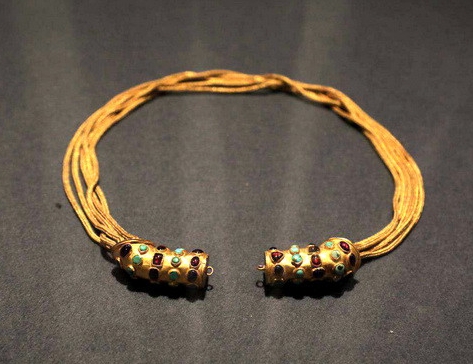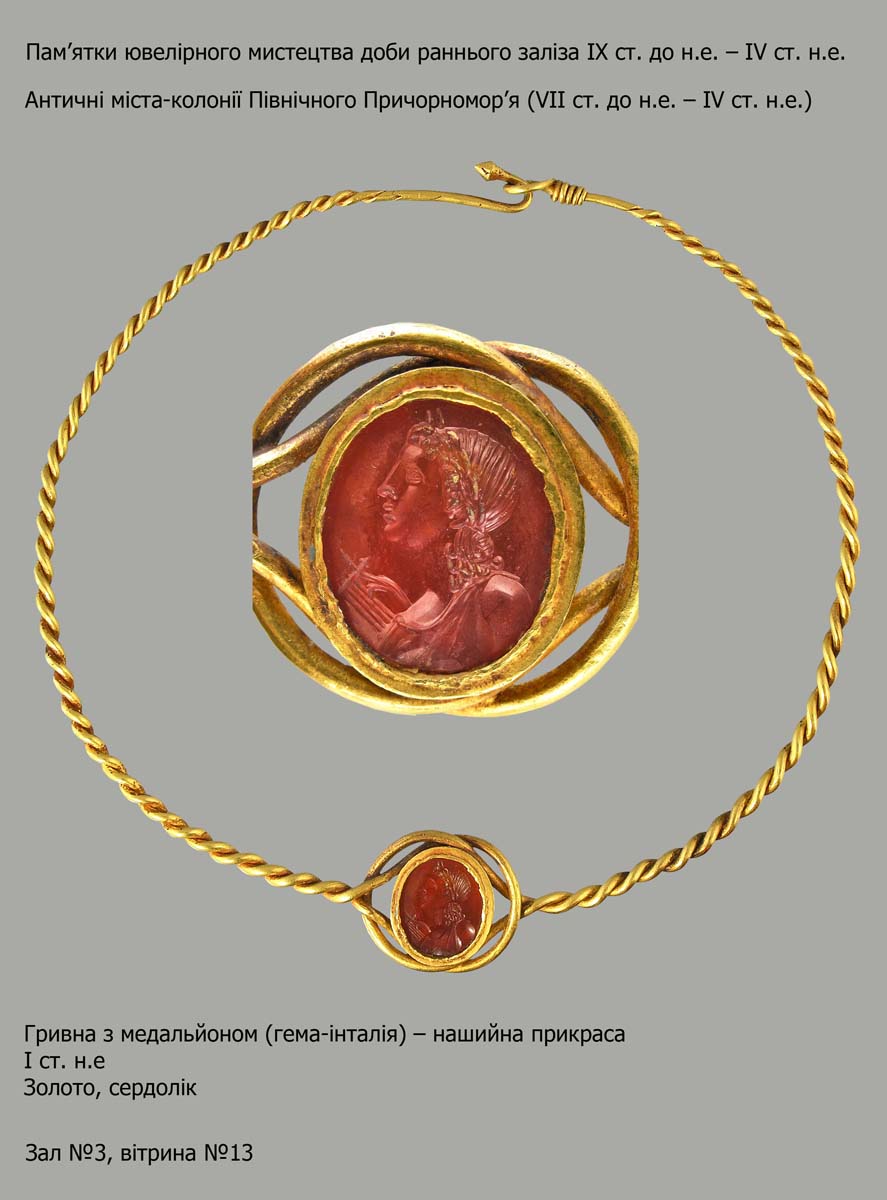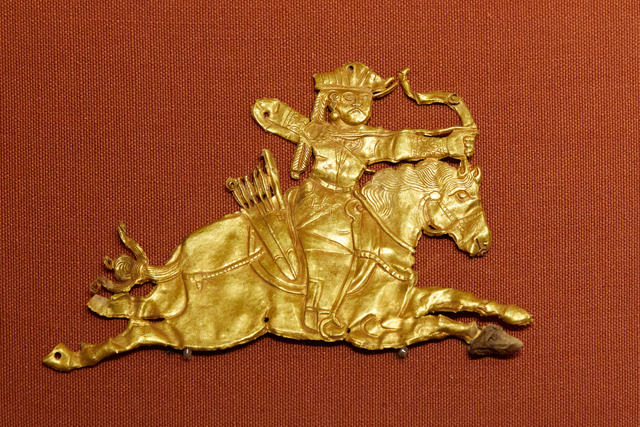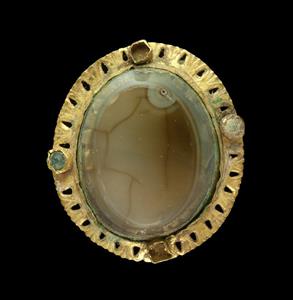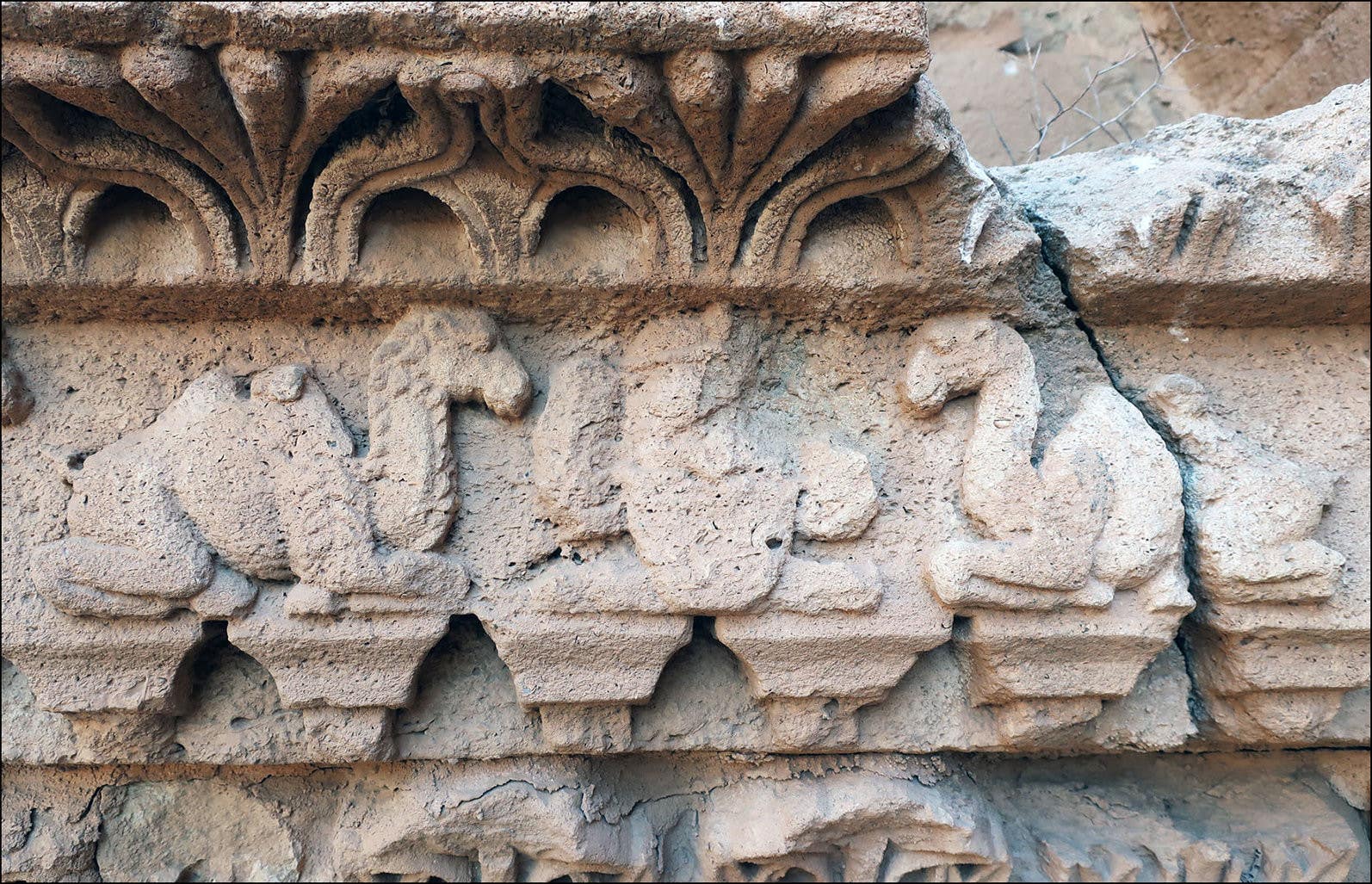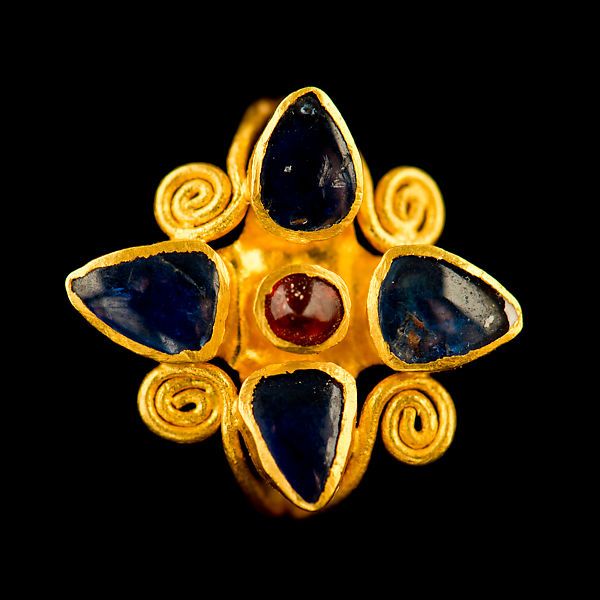
Gold buckle with boar hunting scene, 2nd-1st century BCE or 1st-2nd century CE. Tajikistan, Saksanokhur
There are two different dates given, by Museum Guimet and by German’s Museums. Both dates are likely. [read more]

Inlaid gold plaque depicting a man leading a camel; 1.9 x 1.6 cm.
From Takht-i Sangin, the Oxus Temple

Photo source https://halva.tj
Half of the gold mural crown, it weighs about 149 grams, is 35 cm long and 17 cm high.
Kushan period, 1st century BCE – 1st century CE.


Bronze phalera with an image of young Dionysus; 1st century BCE – 1st century CE. It was found on the territory of the modern city of Dushanbe.
Diameter 14.4 to 14.5 cm. Medallion consists of two round plates – front and back – fixed by bronze rims (4.5 mm wide) and eleven rivets. On the back of phalera, a clasp for passing the belt is fixed to the base with a tack. It is attached crosswise to the phalera.
National Museum of Antiquities of Tajikistan (Dushanbe)

https://www.arts-in-the-city.com/2021/11/23/le-musee-national-des-arts-asiatiques-guimet-presente-lexposition-tadjikistan-le-pays-des-fleuves-dor/

Gold earring in the shape of a Sphinx. Found in the city of Dushanbe, it was made 2nd-1st century BCE. Made of electrum, a mixture of gold and silver. The size of the earring is 3.5 x 2.2 cm



Артамонов М.И. Сокровища саков
Artistic monuments of the Saks of Central Asia and Western Siberia
“In the large Tulkhar burial ground with burials of this kind, excavated by A.M. Mandelstam in the Bishkent valley near the Kobadian oasis in southwestern Tajikistan, among a small and monotonous inventory, several gold jewelry were found. Particularly remarkable are earrings with amphora-shaped pendants, the handles of which are interpreted in the form of curved stylized dolphins and a pair of pendants in the form of a bird with outstretched wings, decorated with a geometric pattern of turquoise inserts with a white oval stone in the middle. (…)
In general, the burial ground, according to the conclusion of A.M. Mandelstam, refers to the period from the last third of the II century. BC. before the beginning of the 1st c. AD. The appearance of burial grounds of the Tulhar type in the basin of the middle Amu Darya, in all likelihood, is associated with the invasion of nomadic tribes there, which put an end to the Greco-Bactrian kingdom.”

Gold, bronze, pearls, glass paste, 1.5×2.5 cm,1.4×2.3 cm. Ring made of thin bronze wire with a movable winding lock. On the bow there is an “amphora-shaped” pendant, similar to No. 271. The middle part of the “amphora” is a pearl, the upper and lower parts are made of dark glass paste with external gilding. Amphora handles in the form of fully stylized dolphins. The completion of the suspension rod is a pearl and a pyramid of grain. The side hangers are missing.
Burial ground BM-V.
1st-2nd century CE
Lit.: see No. 266; YUT No. 167 – 168.

Earrings with dolphins. Gold, glass paste. 1.5 x 2.6 cm; 1.3 x 2.3 cm
The locks have been lost, only pendants in the form of amphorae have survived. Three beads are strung on a golden rod ending in a pyramid of four balls of grain, making up the body of the amphora. Above – a massive ring for hanging, to which handles in the form of highly stylized dolphins were attached on both sides.
I – III centuries. n. e.
Dushanbe, National Museum of Antiquities of Tajikistan, KP 589.
Lit.: Fayazova 1977, p. 35; YUT No. 217.

Gold, turquoise, glass paste. 1.9 x 3 cm
The lock is a hook made of a wire round in cross section. Two-part shield: large – round, small – in the form of a segment. Framed along the edge with pyramids of granulation. Inside the shields there are figured nests for inserts made of turquoise and pink glass paste (golden partitions are soldered). Burial ground BM-VII.
1st-2nd century CE
Lit.: Sedov 1979, p. 584 – 585; YUT No. 157.

Gold, turquoise, garnet (?). Length with suspension 5.9, the actual plate – 1.8.
Similar to No. 285. The surviving length of the wire pendant is 2.6 cm, at the end of which is a disk made of thin sheet gold (diameter 1.25). Turquoise and garnet (?) inserts have also been preserved.
Burial ground of Ksirov III, fence No. 19.
I c. BC e. – II century. n. e. Inv. No. 47/1.
Lit.: YUT No. 180.

Pendant and earrings from the Kushan Empire, 1st-2nd century.
(a) pendant 274 (length 24 mm, width 10 mm, weight 1.870 g); (b) pendant 267 (length 30 mm, width 19 mm, weight 3.780 g); (c) pendant earring 270 (length 55.9 mm, disc length 18.0 mm, width 10.5 mm, weight 2.483 g);
(d) earring 271 (length 38.0 mm, width 10.0 mm, weight 3.447 g);
(e) earring 274 (length 23 mm, width 14 mm, weight 1.654 g).
From the publication: “Analytical study of the manufacturing techniques of Kushan gold jewellery (National Museum of Antiquities of Tajikistan)” >> https://journals.openedition.org
“Three of them were found in the Beshkent Valley and are dated to a period between the 1st and the 2nd century AD: an amphora-shaped pendant and a globular openwork pendant, found in the mid 1970s during the excavation of the Beshkent – cemetery V (Figs. 2a and 2b); and a cloisonné pendant found in 1978 during the excavation of the Beshkent cemetery VII (Fig. 2c). The pendant earring (Fig. 2d) was found in the late 1970s during the excavation of the Ksirov cemetery III, mortuary enclosure 19, in the Dangara Valley and is dated to a period between the 1st century BC and the 2nd century AD. Finally, an amphora-shaped earring dated to a period between the 1st and the 2nd century AD was found in 1973-1974 during the excavation of the “Ittifoq” cemetery in the Parkhar Valley (Fig. 2e).”
“Globular pendant (Fig. 2b) consists of an iron pyrite bead covered with an open net birdcage”
to compare

Predynastic and New Kingdom [16th-11th C BCE], or later.
Private collection: ex collection P.M. Busch, received as a gift before 1953, said to have been found in a “princess” tomb
“This unique pendant is covered by a golden net over a greenish iron-ore core. This core once has been an amulet by itself due to its perforation, perhaps already in predynastic times. The material, the Egyptian bjA can be translated as “material from a star”. The same word is used as a designation for the weight on a net. The floats of the fishing-net are according to the Coffin Texts the precursors of the sun god Ra, the stars visible shortly on the eastern horizon just before the heliacal sunrise on June 17th/18th. This net of stars with its weights of bjA is feared by the deceased during his journey to the netherworld. Therefore, the altogether 78 (13×6) dots probably represent stars which trapped in a net surround the weight, the former iron-ore pendant, so that they no longer can harm the deceased. In this way the pendant becomes a protective amulet.
A comparable pendant bought in 1859 for the collection in Cairo has been dated by Maspero to dynasty 20th, while a pendant globe from the collection of Melvin Gutman has been assigned by Hoffmann and Davidson to the 5th/4th century BC.”
ANCIENT EGYPT
Masterpieces from Collectors and Collections
10th Edition of the Brussels Ancient Art Fair, 2012
https://www.academia.edu
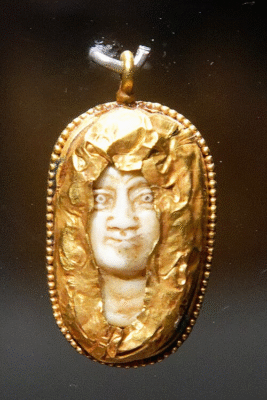
Photo © Marie-Lan Nguyen

Photo ©Thierry Ollivier for the MNAAG
Gold medallion, a setting for a Roman chalcedony cameo, discovered in Tajikistan in the fortress of Shirin; 4th-6th century. 2.2 x 1.4 cm
National Museum of Antiquities of Tajikistan, Dushanbe, KP 942/766.
https://commons.wikimedia.org/wiki/File:Medallion_cameo_reverse_NMAT_KP942-766.jpg

Photo ©Thierry Ollivier for the MNAAG
Torso of a princely figure, devote or Bodhisattva.
7th/8th century; H: 75 cm
From Adjina-Tepe, Vakhch district

Photo ©Thierry Ollivier for the MNAAG

The sculpture of a woman (charred tree), ears are clearly visible, in which there are two earrings. The face of the sculpture has not been preserved, only the head, body, part of the shoulders, arms and part of the legs. Necklaces and bangles are visible on the chest and legs. The height of the sculpture is 55 cm, length – 20 cm, and width – 11 cm. The sculpture was found in the city of Bunjikat.

Photo source
Gold and turquoise rosette from the tomb of the “Princess of Sarazm”.
Beginning of the 3rd millennium BCE.
H. 1.5;D. 5.5 cm
National Museum of Antiquities of Tajikistan, SZM 5-190

Ivory scabbard with the lion and deer, late 6th-early 5th century BCE.
27.7 x 11 cm
SOURCES
Pictures and descriptions of the exhibition
- An exhibition in Paris, Musée Guimet https://www.artoftheancestors.com/blog/tajikistan-musee-guimet
- “Tadjikistan, au pays des fleuves d’or au Musée Guimet” https://www.coupefileart.com
- An article by Bernadette Arnaud: L’exposition “Au pays des fleuves d’or” ouvre les portes du Tadjikistan https://www.sciencesetavenir.fr
- «Таджикистан – страна золотых рек»: рассказываем о самых интересных экспонатах таджикской выставки во французском музее Гиме https://halva.tj
- Le Musée National des Arts Asiatiques – Guimet présente l’exposition Tadjikistan le pays des fleuves d’or https://www.arts-in-the-city.com/2021
- https://scribeaccroupi.fr/visite-privee-tadjikistan-au-musee-guimet/
- https://www.zum.de/Faecher/G/BW/Landeskunde/rhein/kultur/museen/ma_reiss/ausst/alexander/rundgang.htm
- https://www.spektrum.de/news/alexander-oeffnet-die-welt/1010101
- Gunvor Lindström, Weihgaben aus dem Oxos-Tempel in Tacht-i Sangin, Tadschikistan. In: N. Boroffka/S. Hansen (Hrsg.), Archäologische Forschungen in Kasachstan, Tadschikistan, Turkmenistan und Usbekistan (Berlin 2010) 58–63. https://www.academia.edu
- Francfort, H.-P., “Sur quelques vestiges et indices nouveaux de l’hellénisme dans les arts entre la Bactriane et le Gandhāra (130 av. J.-C.-100 apr. J.-C. environ)”, Journal des Savants, (janvier-juin), p. 3-114. https://www.academia.edu
- Артамонов М.И. Сокровища саков Artistic monuments of the Saks of Central Asia and Western Siberia
Literature
- ИСТОРИЯ ТАДЖИКСКОГО КОСТЮМА/History of Tajik Costume Volume 1 by Guzel Maitdinova
https://www.academia.edu



